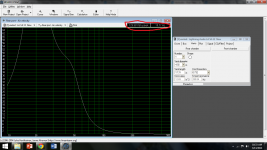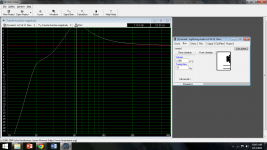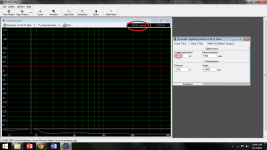Hi, I'm a newbie on the arena of speaker buillding, so apologies in advance if the question is dumb. 😱
So while designing a ported sub enclosure on winISD I noticed the cone excursion is way too low even on max input power of 340 W - it's just 0.059" inches according to winISD! the driver is a Lightning Audio LA S4-12 SVC 12", with a rated xmax of atleast 0.75". The would be a 15" x 17" x 18" 2 cub.ft. one with a 4" x 17" round aeroport tuned at around 29 Hz. Max Rear port air velocity as I noted is 125.58 ft/s, which I guess is normal? Anyways, What am I doing wrong here? Why is the excursion so low? As far as I know the T/S parameters are correctly entered -




Tips and any sort of advice appreciated!
So while designing a ported sub enclosure on winISD I noticed the cone excursion is way too low even on max input power of 340 W - it's just 0.059" inches according to winISD! the driver is a Lightning Audio LA S4-12 SVC 12", with a rated xmax of atleast 0.75". The would be a 15" x 17" x 18" 2 cub.ft. one with a 4" x 17" round aeroport tuned at around 29 Hz. Max Rear port air velocity as I noted is 125.58 ft/s, which I guess is normal? Anyways, What am I doing wrong here? Why is the excursion so low? As far as I know the T/S parameters are correctly entered -




Tips and any sort of advice appreciated!
Hi,
That driver cannot be vented and certainly not in a 2cuft box.
Best used in a sealed and very well stuffed 2 to 3 cuft box.
The recommended boxes are silly for a Qts = 0.83 driver.
rgds, sreten.
That driver cannot be vented and certainly not in a 2cuft box.
Best used in a sealed and very well stuffed 2 to 3 cuft box.
The recommended boxes are silly for a Qts = 0.83 driver.
rgds, sreten.
Last edited:
Probably you have a units problem when entering the data.
Here is a model for that woofer in my sheet. When you get winISD to look something like this, you will be on track. This particular sheet shows the excursion at 50 watts or P_input on the first page.
The woofer doesn't look to me like it would have 18mm one way xmax so I put in 9, which is probably still generous.
This is with the manufacturer recommended 2cubic foot box tuned to ~33Hz with 2x 3"x14" ports.
Here is a model for that woofer in my sheet. When you get winISD to look something like this, you will be on track. This particular sheet shows the excursion at 50 watts or P_input on the first page.
The woofer doesn't look to me like it would have 18mm one way xmax so I put in 9, which is probably still generous.
This is with the manufacturer recommended 2cubic foot box tuned to ~33Hz with 2x 3"x14" ports.
Attachments
change the cone excursion units to MM. You need to go into the program options to do this. It is not as simple as double clicking the Xmax figure in the T/S parameter entry box.
Also, please tell us: why have you entered 1.9ohm for series resistance??
Also, please tell us: why have you entered 1.9ohm for series resistance??
@sreten - Thanks for the input, yes, although it was acknowledged by me that drivers with Qts beyond ~0.4 are not suited for ported enclosures, I just thought of giving it a shot as the manufacturer had given the apparently "ideal?" dimensions for a vented box. Looks like there might be a few major design changes to be considered for the box. On a side note, what might be the consequences of having a 0.8 qts driver in a 2 cub.ft. box with a 4"x15" port? Would it be loss of cone control? Non-linearity at higher excursion rates?
@Ron E - Thanks for that valuable piece of info! It was pretty darn difficult to find a pdf spec sheet for this model. Anyways, inputting the new t/s values for power at 270 W (an average on my amp), I get a max cone excursion of 1.207 inch (30.65 mm) on a one-way peak plot, which crosses the safe xmax limit well enough. What's the deal here? I'm pretty sure by now that I have entered correct t/s parameters. Also, will I be better off with a sealed enclosure? Maybe it's the vented box causing overexcursion?
@Oscar S - Yup, a very silly mistake on my part. Thanks for pointing that out. And yeah, changing the units helped. Alot.
@Ron E - Thanks for that valuable piece of info! It was pretty darn difficult to find a pdf spec sheet for this model. Anyways, inputting the new t/s values for power at 270 W (an average on my amp), I get a max cone excursion of 1.207 inch (30.65 mm) on a one-way peak plot, which crosses the safe xmax limit well enough. What's the deal here? I'm pretty sure by now that I have entered correct t/s parameters. Also, will I be better off with a sealed enclosure? Maybe it's the vented box causing overexcursion?
@Oscar S - Yup, a very silly mistake on my part. Thanks for pointing that out. And yeah, changing the units helped. Alot.
@sreten - Thanks for the input, yes, although it was acknowledged by me that drivers with Qts beyond ~0.4 are not suited for ported enclosures, I just thought of giving it a shot as the manufacturer had given the apparently "ideal?" dimensions for a vented box. Looks like there might be a few major design changes to be considered now. On a side note, what might be the consequences of having a 0.8 qts driver in a 2 cub.ft. box with a 4" x 15" port? Would it be loss of cone control? Non-linearity at higher excursion rates?
@Ron E - Thanks for that valuable piece of info! It was pretty darn difficult to find a pdf spec sheet for this model. Anyways, inputting the new t/s values for power at 270 W (an average on my amp), I get a max cone excursion of 1.207 inch (30.65 mm) on a one-way peak plot, which crosses the safe x-max limit well enough. What's the deal here? I'm pretty sure by now that I have entered correct t/s parameters. Also, will I be better off with a sealed enclosure? Maybe it's the vented box causing over-excursion?
@Oscar S - Yup, a very silly mistake on my part. Change it to 4 ohms now. Thanks for pointing that out. And yeah, changing the units helped. A lot.
@Ron E - Thanks for that valuable piece of info! It was pretty darn difficult to find a pdf spec sheet for this model. Anyways, inputting the new t/s values for power at 270 W (an average on my amp), I get a max cone excursion of 1.207 inch (30.65 mm) on a one-way peak plot, which crosses the safe x-max limit well enough. What's the deal here? I'm pretty sure by now that I have entered correct t/s parameters. Also, will I be better off with a sealed enclosure? Maybe it's the vented box causing over-excursion?
@Oscar S - Yup, a very silly mistake on my part. Change it to 4 ohms now. Thanks for pointing that out. And yeah, changing the units helped. A lot.
@Oscar S - Yup, a very silly mistake on my part. Change it to 4 ohms now. Thanks for pointing that out. And yeah, changing the units helped. A lot.
Your series resistance should equal the output impedance of your amplifier plus the resistance of any wire or inductors between your amp and speaker. Typical would be perhaps 0.05 to 0.2 ohms total for a solid state amp, and as much as an ohm or two for a tube amp and/or long wire runs. Before you start asking shotgun questions based on your misuse of the software, you really need to take some time and learn the tools.
IMO, any speaker with a Qts over 0.5 is probably not suited to a vented enclosure. BTW, the parameters I filled in are guess values based on long experience.... Also in my opinion you would rarely want to run any speaker or amplifier at much more than 10-20% of its long term power rating for any length of time, for the simple reason that music is not a sine wave and there are peaks that can be ~10dB higher than the average (that means 10x the power) and if you want these to be reproduced with fidelity you need headroom....
That woofer system will sound fine as designed if you want it to thump, but the woofer will be fairly easy to overdrive below tuning..
@sreten - Thanks for the input, yes, although it was acknowledged by me that drivers with Qts beyond ~0.4 are not suited for ported enclosures, I just thought of giving it a shot as the manufacturer had given the apparently "ideal?" dimensions for a vented box. Looks like there might be a few major design changes to be considered now. On a side note, what might be the consequences of having a 0.8 qts driver in a 2 cub.ft. box with a 4" x 15" port? Would it be loss of cone control? Non-linearity at higher excursion rates?
@Ron E - Thanks for that valuable piece of info! It was pretty darn difficult to find a pdf spec sheet for this model. Anyways, inputting the new t/s values for power at 270 W (an average on my amp), I get a max cone excursion of 1.207 inch (30.65 mm) on a one-way peak plot, which crosses the safe x-max limit well enough. What's the deal here? I'm pretty sure by now that I have entered correct t/s parameters. Also, will I be better off with a sealed enclosure? Maybe it's the vented box causing over-excursion?
@Oscar S - Yup, a very silly mistake on my part. Change it to 4 ohms now. Thanks for pointing that out. And yeah, changing the units helped. A lot.
make that two silly mistakes because as was mentioned, "series resistance" is not in any way related to the speaker's impedance nor DC resistance. That part is taken care of in the Driver parameter entry screen, not anywhere else. Someone needs to read the Help File. 🙂
Only one thing causes over-excursion: to much power. 😀 But yea, too much power in combination with box specs and tuning often cause over excursion if not dealt with a High-pass filter.
Drivers look nice. They make me think of the new Magico S3 (and the Expolinear ATD Hypergraphs). 😀
Lightning Audio® : Product Details
Lightning Audio® : Product Details
Attachments
@Ron E and OscarS - I sure do have a lot to read. Got everything upside-down. But ever ready to explore. :O
@Inductor - Haha indeed 😀, part of the reason why I chose this driver was cause of the cheap price-tag (50$) for a beginner, whilst still being a 12. Little did I know about how one should ideally shoot for a lower-qts driver.
Well, I guess making the switch to a 15" x 18" x 10" sealed design would be a safer target, don't wanna blow the sub on a vented.
@Inductor - Haha indeed 😀, part of the reason why I chose this driver was cause of the cheap price-tag (50$) for a beginner, whilst still being a 12. Little did I know about how one should ideally shoot for a lower-qts driver.
Well, I guess making the switch to a 15" x 18" x 10" sealed design would be a safer target, don't wanna blow the sub on a vented.
@ Basshead69
You might find this helpful. http://www.diyaudio.com/forums/subwoofers/148729-how-correctly-use-winisd.html
You might find this helpful. http://www.diyaudio.com/forums/subwoofers/148729-how-correctly-use-winisd.html
Hi,
That driver cannot be vented and certainly not in a 2cuft box.
Best used in a sealed and very well stuffed 2 to 3 cuft box.
The recommended boxes are silly for a Qts = 0.83 driver.
rgds, sreten.
Actually they are not, considering the purpose of this driver - for car audio duty. I've seen that type of vented alignment before (the JBL MS series of subwoofer drivers, for example). The idea behind it apparently is to use the alignment to boost the subwoofer's output at or above where the car's transfer function starts to take effect, and create an approximate 12dB/octave rolloff below that down to Fb, the end result being a louder and flatter in-car response due to the car's transfer function.
It may be possible to repurpose the same alignment for use at home, with a bit of active EQ. For example, if driven by one of those Behringer DSP amps to address the hump above Fb via EQ.
Thanks very much, Zero, very useful for getting started with WinISD! 🙂@ Basshead69
You might find this helpful. http://www.diyaudio.com/forums/subwoofers/148729-how-correctly-use-winisd.html
- Status
- Not open for further replies.
- Home
- Loudspeakers
- Subwoofers
- Cone excursion plot too low on WinISD help


